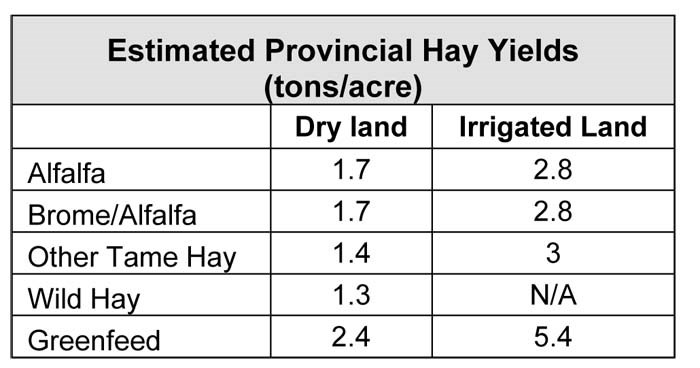Harvest operations are underway in the province. Thirty-five per cent of the winter wheat, 25 per cent of the fall rye, four per cent of the peas and one per cent of the lentils are combined, according to Saskatchewan Agriculture’s weekly Crop Report. Haying operations continue with 79 per cent of the hay crop now baled or put into silage and 10 per cent cut and ready for baling. Continuous rain has caused haying and harvest delays.
Hay quality is rated as 59 per cent good, 36 per cent fair and five per cent poor. Hay is slow to dry in the swath due to the high humidity and rain. Provincial hay yields are reported as 1.7 tons per acre for alfalfa and alfalfa/bromegrass, 1.4 tons per acre for other tame and wild hay, and 2.4 tons per acre for greenfeed.
Harvest in the southeastern region is the furthest advanced. Eighty-two per cent of the winter wheat, 16 per cent of the peas and two per cent of the lentils have been combined in the region, and six per cent of the canola has been swathed. In comparison, 11 per cent of the winter wheat and four per cent of the peas have been combined in the southwest. Canola is С����Ƶ swathed and pulses are С����Ƶ desiccated in various areas of the province.
It was another extremely wet week for the majority of the province, with many areas receiving heavy downpours that caused crop damage due to lodging and flooding. The Rhein area received 120 mm of rain, Langham 112 mm, Rosetown 99 mm, Tisdale 96 mm, Kyle 94 mm, Jedburgh 92 mm, Leader 84 mm, Moose Jaw 79 mm, Cando 63 mm, Kinistino 60 mm and Glaslyn 46 mm. Having received 537 mm of rain since April 1, the Kyle area holds the provincial record for cumulative rainfall. The driest part of the province is the Speers area, which has received only 108 mm of rain since April 1. A few areas in the far southeast and northwest received little rainfall during the past week.
Due to the excess moisture, field access will be an issue for producers in some areas, and wet fields may result in harvest equipment getting stuck. Lentils and peas in many areas of the province have suffered from season-long excess moisture. Diseases and hail have also caused crop damage.
Provincially, cropland topsoil moisture is rated as 26 per cent surplus, 70 per cent adequate and four per cent short. Hay land and pasture topsoil moisture is rated as 12 per cent surplus, 80 per cent adequate and eight per cent short.
Farmers are busy haying, desiccating and harvesting when weather allows.
С����Ƶeastern Saskatchewan:
• Crop District 1 – Carnduff, Estevan, Redvers, Moosomin and Kipling areas
• Crop District 2 – Weyburn, Milestone, Moose Jaw, Regina and Qu’Appelle areas
• Crop District 3ASE – Radville and Lake Alma areas
Harvest operations are underway in the region. Eighty-two per cent of the winter wheat, 53 per cent of the fall rye, 16 per cent of the peas and two per cent of the lentils are in the bin. Six per cent of the canola has been swathed. Peas and lentils are С����Ƶ desiccated and other crops are turning quickly. Many areas of the region received little rainfall, which allowed harvest and haying operations to continue.
Eighty-five per cent of the hay crop is baled and nine per cent has been cut. Hay quality is rated as 85 per cent good and 15 per cent fair.
It was a dry week in the region compared to the rest of the province. Crop District 2B received the majority of the rainfall. Precipitation ranged from nil to 51 mm (Moose Jaw). The Carnduff area received 31 mm, Maryfield 6 mm, Weyburn 17 mm, Marquis 40 mm and Ceylon 8 mm. The Lampman, Kisbey and Stoughton areas reported no rain for the week. Some fields have begun to dry up. Crops in the Stoughton and Weyburn areas are reported to be in good condition.
Cropland topsoil moisture is rated as 19 per cent surplus, 71 per cent adequate and 10 per cent short. Hay land and pasture topsoil moisture is rated as nine per cent surplus, 72 per cent adequate and 19 per cent short. Crop District 1B is reporting that 26 per cent of cropland acres have surplus topsoil moisture at this time. Twenty-four per cent of hay land and pasture in CD 1B has surplus topsoil moisture. Crops have been lost to flooding and disease.
Crop damage this week was mainly caused by lodging and disease. Hail was reported in the Oxbow and Indian Head areas. A wet growing season has resulted in some crop loss from disease. Some producers have commented that they are unsure of lentil yields as the excess moisture throughout the growing season has resulted in poor podding.
Producers are trying to finish haying, desiccating, swathing and combining.
One year ago
Harvest was underway with four per cent combined. Thirty-three per cent of the winter wheat, 15 per cent of the lentils and 19 per cent of the peas had been combined. Rainfall ranged from trace to over 75 mm in some areas.
Follow the Crop Report on Twitter @SKAgriculture




